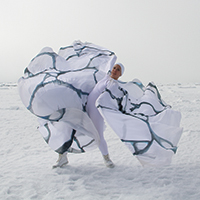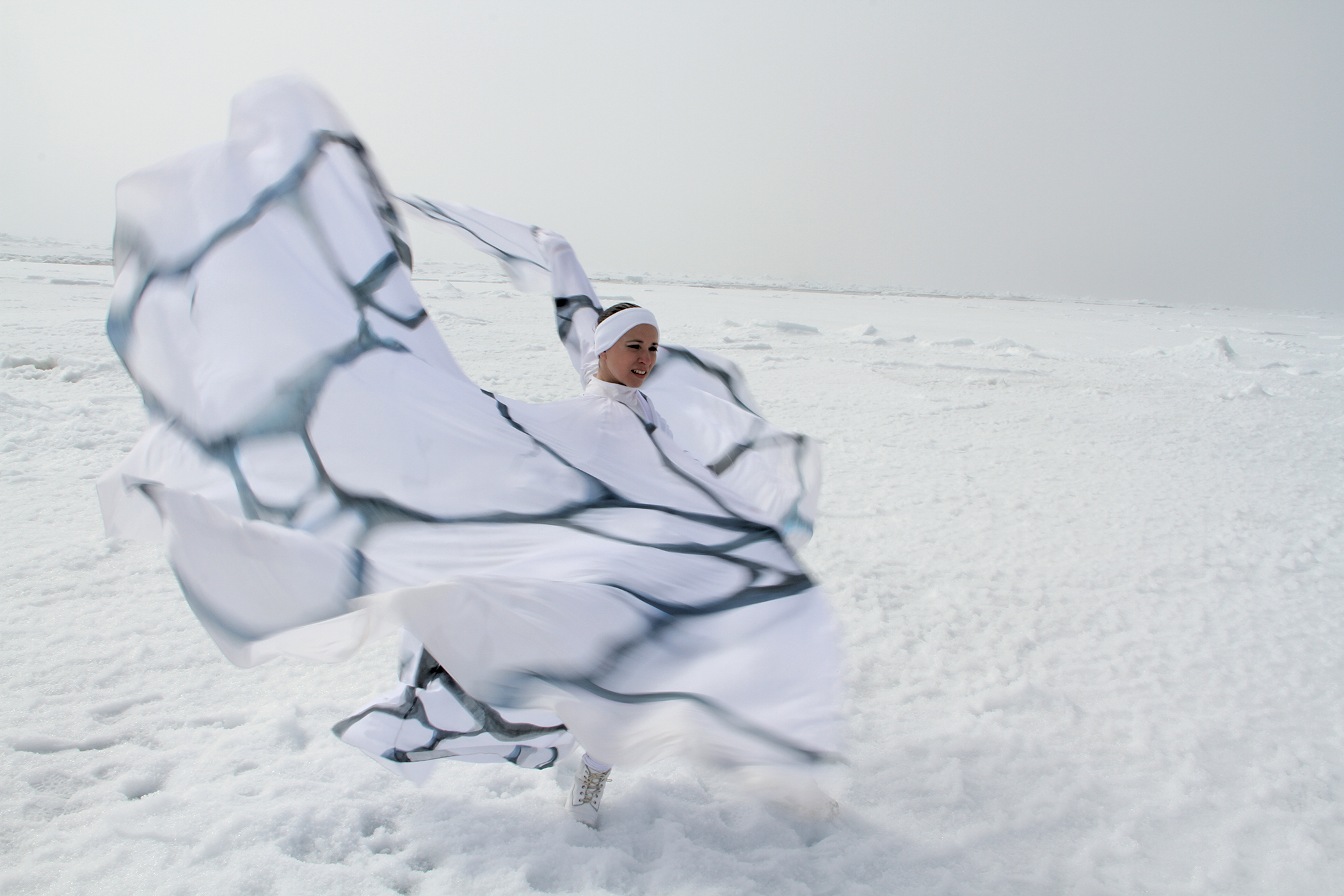JODY SPERLING ’92: DANCING IN THE ARCTIC


By David McKay Wilson
When choreographer Jody Sperling ’92 traveled to the Arctic Ocean last spring to find inspiration for her upcoming stage piece, she planned to dance on the planet’s dwindling northern icescape.
Near the start of her 43-day journey aboard the U.S. Coast Guard Cutter Healy, she wasn’t sure if the weather would cooperate, as low clouds hung on the horizon. So she ventured out on the ice, with cameras rolling, not long after the ship anchored at an ice floe.
She donned her hand-painted costume of billowing white silk, in the fashion of modern-dance pioneer Loie Fuller, which added another layer of challenge to her movement, when an arctic gale kicked up.
“Here I was leaning into the wind, dancing in an arctic squall, staggering through crunchy slush and getting pelted by large wet snowflakes,” she wrote in her online blog. “The wind kept tangling my costume. I wiped out a few times. By shoot’s end, I was utterly exhausted, freezing, and also strangely exhilarated. I felt the satisfaction of having done something that no one has ever done, and few could possibly be so foolish to try. This was dancing in the Arctic! And I couldn’t wait until the next time.”
She danced a dozen times over the ensuing weeks, as she served on the “outreach team” of the research vessel whose scientific crew was studying the thinning ice cap, including the impact of climate change on how phytoplankton blooms beneath the ice. Her dances on sunnier days were captured on an almost three-minute-long video, in which she swirls and undulates solo across the vast expanse of ice, with the ethereal soundtrack from recordings made underwater more than 50 years ago.
“It was a real challenge, with the landscape so vast, to make your movement have some significance,” she says. “It was hard to improvise when it was 12 degrees outside, and I was not wearing gloves. We have a long blooper reel.”
Just a week after returning from her journey, she showed the video at the Jewish Community Center in Manhattan. There, she spoke about the confluence of science and art, which she believes will help spark a conversation among her audiences about one of the world’s greatest environmental challenges.
She shared the motivation that fuels her latest work, which she developed north of the Bering Strait, between 69 and 73 degrees North latitude, where seals and polar bears live and the sun does not set in the late spring.
Her dance-theater piece under development, called Life Cycle of Ice, will incorporate a discussion about climate change into its performance.
“I’ve long been concerned with climate change, and now have a 3-year-old daughter who will see dramatic changes in her lifetime,” says Sperling, 44, who lives in Manhattan with her husband, Doug Fox, and daughter, Evie. “I’m captivated by the beauty of the sea ice, and want to portray its fragility and dynamism.”
Sperling’s climate-change project is the latest undertaking in a modern-dance career that began at Wesleyan, where she majored in dance, studying with Cheryl Cutler, Susan Lourie, Willie Feuer, and the late Cynthia Novack, her thesis adviser.
A Manhattan native, she returned to Greenwich Village after graduation to earn a master’s degree in performance studies at New York University and explore the vibrant downtown experimental dance scene with Wesleyan dancers Kelly Donovan ’93, Emily Faulkner ’86, Clarinda MacLow ’87, Wendy Blum ’87, Molly Rabinowitz ’87, and Aggie Postman ’94. She made ends meet by filming dance performances, writing dance criticism for the weekly Village Voice, and creating captions for 2,200 illustrations in the International Encyclopedia of Dance.
Her 18-month engagement, writing for the encyclopedia, was a turning point for direction in dance. The encyclopedia’s managing editor was Elizabeth Aldrich, a choreographer and social-dance historian, who had been commissioned to mount a production in the Thomas Jefferson Building’s rotunda at the U.S. Library of Congress to celebrate its centennial in 1997.
Aldrich wanted to set Sperling on a Fuller-style Butterfly Dance, which Sperling performed with an 18-piece brass band playing Wagner’s “Ride of the Valkyries.” She danced in a green skullcap and a pink costume that featured an 18-foot wingspan to replicate Fuller’s stage attire from a century earlier. She became enthralled by the way the costume took her movement into another realm. “It was slightly comic, and sublime,” she recalls. “But I got hooked expanding my dance into all that space. I wanted to explore more. I wanted to go beyond myself into that expansive kinesphere.”
So Sperling set off researching the work of Fuller, who lived from 1862 to 1928. She recreated one of Fuller’s earlier dances, and by 2000 had established her company, Time Lapse Dance, as the vehicle for her choreography. Her repertory is performed with six dancers.
The use of Fuller’s flowing silk skirts adds a mesmerizing element to her dances, which have been performed on stages across the U.S., as well as in India, Nigeria, and Bahrain. Silk is translucent, so the dances provide the opportunity for innovative lighting to capture the movement flow, as visualized in the silken swirls.
“The silk has a way of materializing forces you cannot see,” says Sperling. “They are natural forces. When you move through space, you are displacing air, but the vortices and eddies are all invisible. It’s visual art that moves. I’m compelled by the marriage of the visual, the kinetic and the musical. ”
Over the past 17 years, Sperling has developed techniques to manipulate the silk—with some costumes using up to 100 yards of the material.
“Silk is organic, and it flows better than anything else,” she says. “As you move through space, the silk lets you expand your sense of yourself to include the air and the energy field around yourself. The fabric visualizes the forces you are creating. You become aware of your wake and the way you sculpt your own movement.”
It was Sperling’s visualization of such movement—in a piece called Turbulence—that ended up linking her to the scientific community, which led her to the Arctic Ocean last spring, on the Healy, with a crew of 80, and 50 scientists. Back in 2011, Larry Pratt, a senior scientist at the Woods Hole Oceanographic Institute in Falmouth, Mass., had read a New York Times review of Sperling’s dance. He was struck by the movement in the costumes, which illuminated the eddies and ripples in water that were the focus of his scholarly work.
Sperling and Pratt began corresponding. Sperling learned the intricacies of fluid dynamics; Pratt became enthralled by her creative process. She visited him at MIT, and then went to Woods Hole, where she met his colleague, Robert Pickart, the senior scientist who was planning the Arctic expedition. He invited her along.
Pratt came to St. Mark’s Church in Greenwich Village last year to observe a Time Lapse rehearsal. Sperling invited him to take one of her dance classes. Then he brainstormed with Sperling and her dancers.
“I showed them imagery about turbulence and waves, to see if they could riff off it,” says Pratt, who will teach a class about dance and science this fall at MIT. “Then they put it in motion, with such incredible passion.” —DAVID MCKAY WILSON
David McKay Wilson, a freelance journalist whose work has appeared in magazines at 120 colleges and universities, studied dance improvisation at Wesleyan with Susan Lourie and Cynthia Novack in the summer of 1984.
See Jody Sperling’s Bringing Home the Arctic on June 20-21, at the JCC in Manhattan. The evening event includes the premiere of Ice Cycle, a collaboration with Alaskan-born composer Matthew Burtner a specialist in the music of snow and ice. The weekend features three performances, a kids workshop and two climate-themed panel discussions.
For tickets and more information, click here.
Also, see the Bulletin Board at Wesconnect for her posting about this event–and to get her special ticket discount code for the Wesleyan community.



